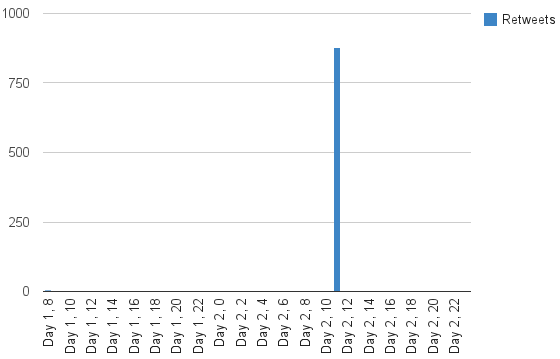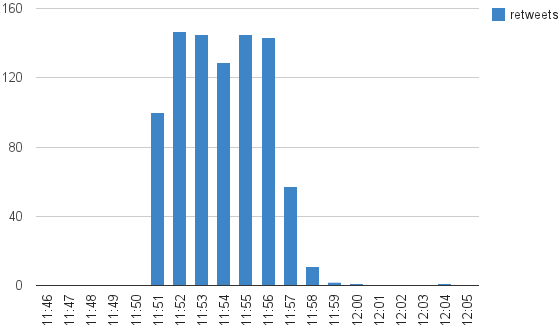Social Media
Going Viral: A Case Study of How One Tweet Went from Zero-to-Thousands of Retweets


BLANCHARD
As much as some people study it, explaining why something goes viral is tough. Predicting it is another animal entirely.
Typically, tracking these waves is near impossible, but to a watchful eye (API restrictions mean if you don’t catch it quickly, it’s usually too late) the public nature of Twitter can give you a clear window into the story.
I’ve been carefully watching resorts and non-resorts alike for a viral tweet to dissect for a while now. Finally, with a little luck, I got my chance last week.
The Numbers
First, let’s look at the numbers. The tweet I was able to analyze didn’t have tens of retweets, it didn’t have hundreds, it had thousands.
Now, please note that I am going going to keep this account nameless. I don’t know how many of you would even recognize it anyway, but, as you’ll read later, there’s no sense raining on their parade for doing nothing wrong.
From direct observation, it seemed most of the retweets came in the first two days, so I first grouped all retweets by hour:
I expected to see a spike, but I didn’t expect this. Interested in what happened during that hour I grouped them by minute around that spike and here’s what I found:
The retweet fest started at 11:51 and by 11:59 it was all but over. With a timeframe for the action, I started to sift through the results manually.
I honestly didn’t expect to find what I did.
Flag #1
You’ll see why i’m calling these flags as I go, but instead of seing valuable takeaways, I started to see things that made me question the value of any of the engagement this tweet received.
But the first was simply the content. It was good, but nothing spectacular. Worthy of a few retweets, but not a few thousand.
Flag #2
Then there was the first retweeter on that second day when the surge of retweets began. The one that, in theory, should have started the tidal wave.
But that account had no apparent popularity or prestige and only 1,274 followers. Not nearly as many as expected.
Flag #3
Next, I looked at the exact times the wave started. That first retweet happened at 11:51:23.
But by the time that 23rd second was over, the original post had been retweeted another 12 times.
Flag #4
Then, the following count of that first retweeter caught my eye: 1,997.
Why? Well, keep in mind that the maximum number of people you can follow is either 2,000 or roughly 110% of your follower count (whichever is higher).
Accounts that push the limits (usually automated) often have following counts right around 2,000, but almost never more than 2,000. During the first minute of the wave, 23 accounts were within a few of 2,000 without going over.
Flag #5
A normal following:follower ratio for a personal account is usually between 1:1 and 7:1. Brands are more about broadcasting, so theirs are even lower. Resort accounts average 0.75:1. But automated accounts often have a crazy ratio of 30-40:1 or higher.
The following:follower ratio of the retweeters during this wave was 62:1. For every 1,000 people they followed they had about 16 followers of their own.
What Does This Mean?
So, add up all these factors and what do you get? Well, I’ll give you my best guess.
Something in the tweet – a hashtag, a keyword, a phrase – matched a trigger that an army of spam bots was looking for. When they saw it, they went crazy. When they were done, they were done. Thousands of retweets but almost no value.
Did the social media manager do anything wrong? No. Of course not. Did they do anything right? Not really.
Chasing Shadows?
The big takeaway I ended up with is simply this: as much as you want to be the next viral success story, keep in mind that you may simply be chasing shadows.
Some viral successes are, without a doubt, legit. Especially on other channels. But the fact that the first viral tweet I got to dive deep on also happened to be driven almost wholly by spam bots tells me that there are probably more shadows out there than we think.
It’s okay to want something to be viral, just keep in mind that viral isn’t always what it seems.
About Gregg & SlopeFillers
I've had more first-time visitors lately, so adding a quick "about" section. I started SlopeFillers in 2010
with the simple goal of sharing great resort marketing strategies. Today I run marketing for resort ecommerce and CRM provider
Inntopia,
my home mountain is the lovely Nordic Valley,
and my favorite marketing campaign remains the Ski Utah TV show that sold me on skiing as a kid in the 90s.
Get the weekly digest.
New stories, ideas, and jobs delivered to your inbox every Friday morning.


